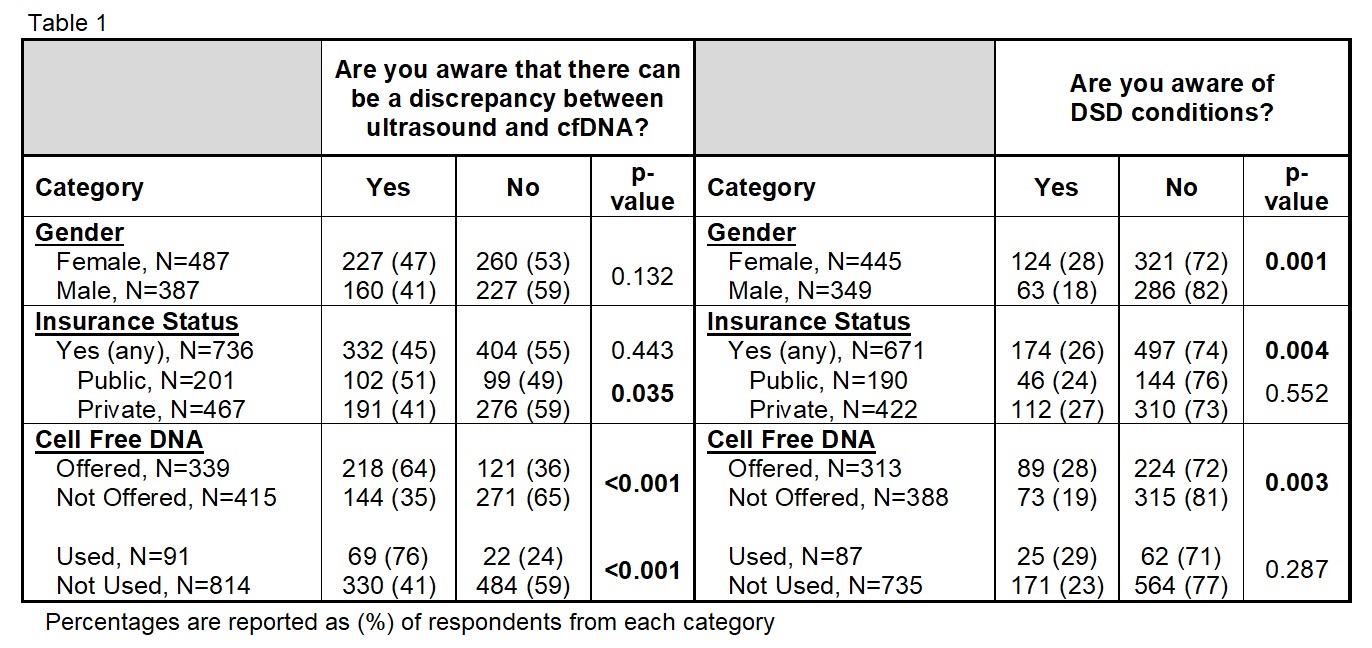Prenatal Sex Determination Among the General Public: Impact of Cell free DNA Testing and Knowledge of Disorders of Sexual Development
Laurel Sofer, MD1,2, Anthony D'Oro, MS1, Ilina Rosoklija, MPH1, Diane Chen, PhD1, Courtney Finlayson, MD1, Emilie K. Johnson, MD, MPH1,2.
1Ann and Robert H. Lurie Children's Hospital of Chicago, Chicago, IL, 22University of Illinois at Chicago, Chicago, IL
BACKGROUND:
Cell free DNA (cfDNA) detects fetal DNA in maternal blood and is offered as a screening test for chromosomal aneuploidies. Families are also told fetal sex (“gender”) determination is possible. Discrepancies between cfDNA and ultrasound in determining fetal sex have been reported, possibly indicating a disorder/difference of sex development (DSD). This study aims to: (1) determine knowledge and use of cfDNA testing for fetal sex, (2) assess general attitudes and behaviors regarding fetal sex determination, and (3) collect preliminary data about psychological functioning in the context of discrepancy between sex identified on cfDNA and ultrasound.
METHODS:
Women and men >18 years old, either currently expecting or had a child in the last year, were eligible. Recruitment was through Amazon Mechanical Turk (AMT), an online crowdsourcing venue. Survey content included demographics, method of fetal sex determination, knowledge of cfDNA and its accuracy in determining sex, distress related to possible inaccuracy of cfDNA, and knowledge of DSD as a possibility. Descriptive statistics and bivariate analyses were performed (Fisher’s exact test).
RESULTS:
Of 916 respondents, 53% were currently pregnant/partner currently pregnant; 47% had a child in the last year. 70% of respondents believe cfDNA is <90% accurate for detecting prenatal sex, 44% were aware a discrepancy between cfDNA and ultrasound regarding fetal sex is possible, and 22% were aware of DSD. Additionally, 78% and 75% reported they would be upset and worried, respectively, if cfDNA and ultrasound results showed a discrepancy regarding fetal sex. Most respondents chose to determine fetal sex prenatally (n=610, 67%). Most also opted to reveal to friends/family (496/610, 81%). In total, 345/913 (38%) reported being offered cfDNA, including 300/633 (47%) with insurance and 35/108 (32%) without insurance (p=0.004). Of those opting to determine fetal sex, 27% pursued cfDNA and 71% pursued ultrasound. Table 1 displays the relationship between respondent factors and awareness of possible discrepancy between US and cfDNA, and awareness of DSD. Notably, respondents who used cfDNA testing were more likely to be aware of possible discrepancy between the tests (76% vs. 41%, p <0.0001), but not about DSD (29% vs. 23%, p = 0.29).
CONCLUSION:
Prenatal sex determination is favored by the majority of expectant parents, and cfDNA testing is now offered widely as one option for “gender” determination. However, this AMT survey indicates that many expectant parents may be unaware of the accuracy of cfDNA for fetal sex determination, the possibility of a discrepancy with ultrasound results, and the (small) potential for detection of a DSD. Moreover, this data indicates most couples would be distressed if cfDNA and ultrasound were incongruent regarding fetal sex, and/or if a DSD were detected. Accurate information about the use and limitations of cfDNA regarding fetal sex determination should be provided to expectant parents.

Back to 2018 Program




